Overwhelmed by tight deadlines, uneven workloads, and constant last-minute scrambles?
If you’re managing multiple projects, resource capacity planning is the key to staying in control. It helps you:
- Take on the right projects without overcommitting
- Ensure your team has enough resources to deliver without burnout
- Keep projects profitable by avoiding unnecessary hiring or rushed staffing decisions
In this guide, you’ll learn what capacity planning is, key strategies to implement, and a simple five-step process to balance workloads and keep projects running smoothly.
Let’s get started.
What is resource capacity planning in project management?
Resource capacity planning (also known as capacity planning) is the process of predicting how much work your team will have in the future and ensuring you have enough people and resources to complete projects on time.
Think of it as aligning your team’s bandwidth with project demands—months in advance.
Effective capacity planning influences the type and volume of work your team takes on. And it shapes hiring decisions, too.
Example of resource capacity in action
Imagine a design agency assessing its workload for the next quarter.
Let’s say the agency has five designers, and each can manage four projects per month. This means the total resource capacity is 20 design projects per month.
Now, if the agency expects 25 projects next month, they face a capacity shortfall of five projects. To address this, they might:
- Hire a freelancer to cover the extra work
- Reallocate tasks among the team
- Postpone or decline lower-priority projects
By analyzing these needs, you can plan ahead and make adjustments—like hiring, reallocating, or training staff—to ensure projects are delivered on time and within scope.
Why is resource capacity planning important?
Resource capacity planning is important as it helps you say goodbye to chaotic schedules, missed deadlines, and overworked employees.
Optimizing your team’s capacity brings a number of benefits, including:
- Greater profitability: Knowing your team’s exact skill sets and availability allows you to set accurate timelines and budgets. This reduces the need for adjustments during projects, leading to higher client satisfaction and improved project profitability.
- Better cost control: By identifying resource limits early, you avoid unplanned overtime costs and address resource bottlenecks before they escalate. This helps prevent unexpected costs from eating into your margins.
- Precise revenue forecasting: With a clear understanding of billable hours, you can set specific utilization goals and forecast revenue based on the actual workload. These data points allow leadership to confidently plan hiring and investments without risking cash flow issues.
- Informed hiring decisions: Capacity planning provides a data-driven view of your team’s bandwidth, helping you avoid both understaffing, which could lead to project delays, and overstaffing, which drives up costs unnecessarily.
- Balanced workloads: By tracking your team’s capacity, you can clearly identify who needs more work or less. And redistribute tasks as needed, helping to prevent costly burnout and disengagement.
- Improved teamwork: With clear role assignments and resource planning, your team avoids last-minute chaos, and everyone knows their responsibilities from the start.
Without resource capacity planning, you’re flying blind—leading to missed deadlines, burnout, and lost revenue. It’s the difference between a well-oiled machine and a chaotic scramble. Teams that plan their capacity effectively stay ahead, deliver on time, and maximize profitability.
What is the difference between capacity planning and resource planning?
The difference between capacity planning and resource planning is that capacity planning ensures you have enough people and resources for future work, while resource planning focuses on assigning the people you already have to projects in the best way possible.
While these terms are often used interchangeably, they serve different purposes in project and team management.
The table below breaks down the key differences:
| Aspect | Capacity planning | Resource planning |
|---|---|---|
| What it focuses on | Forecasting future workload and ensuring enough resources to meet demand | Assigning people, tools, and budgets to projects |
| Timeframe | Long-term (months to quarters) | Mid-term (weeks to months) |
| Goal | Ensure the business has enough resources (people, tools, budget) to meet future demand | Optimize the use of available resources across multiple projects |
| Key questions it answers | – Do we have enough people to handle upcoming projects? – Should we hire, outsource, or redistribute work? – How will our resource needs change over time? | – Who is best suited for each project? – How do we allocate resources efficiently? – Are we overloading or underutilizing team members? |
| Best for | Long-term workforce planning, strategic hiring, and scaling resources | Distributing available resources effectively across multiple projects |
Resource capacity planning strategies
Let’s explore three common resource capacity planning strategies—lag, lead, and match—to help you determine which best suits your project needs and risk tolerance.
1. Lag strategy (wait and see)
The lag strategy involves waiting until demand increases before adding resources. This is like refueling a car only when the tank is almost empty. It’s cost-efficient and avoids overstaffing, making it ideal for steady, predictable workloads.
How it works: Businesses using this strategy scale incrementally as demand rises. And new hires or extra resources are only added when absolutely necessary.
Example: A marketing agency gets 2-3 new retainer clients per quarter and waits until their team is at full capacity before hiring a new strategist.
| Pros ✅ | Cons ❌ |
|---|---|
| You only hire or add resources when necessary, keeping costs low | If demand increases suddenly, your team may struggle to keep up |
| Every hire is based on real demand, so you don’t pay for unused staff | Finding, hiring, and training new staff doesn’t happen overnight, which could slow down projects |
| Best for companies with predictable workloads | If you wait too long, you might have to turn away new projects because you don’t have enough staff |
| Helps keep employees busy before adding more staff | If your business is expanding quickly, this approach may hold you back |
2. Lead strategy (be prepared)
The lead strategy means hiring or allocating resources before they are needed. This approach is proactive—ensuring the team is ready for peak demand periods or rapid business growth.
How it works: Businesses hire or scale up in advance based on projected growth or seasonal demand. This means that teams are not understaffed when big projects arrive.
Example: A consultancy knows January is its busiest month. In December, they hire two new analysts and line up freelancers to handle the increased workload without delays.
| Pros ✅ | Cons ❌ |
|---|---|
| Your team is ready when new work comes in | You may be paying for staff before you actually need them |
| Hiring early avoids last-minute scrambling and burnout | If demand doesn’t grow as expected, you could end up with excess capacity, meaning extra staff with not enough work |
| You don’t have to pause work while waiting for new hires to settle in | Salaries and extra costs can strain finances if new work takes longer to arrive. |
| Works well if you know demand will increase at certain times of the year | If your resource forecasts are wrong, you might hire too early or too late. |
3. Match strategy (find the middle ground)
The match strategy is a mix of lag and lead—scaling resources gradually based on current workload and expected demand.
How it works: Businesses keep a stable core team for steady work and bring in freelancers or contractors for peak workloads.
Example: A creative agency maintains an in-house team for regular projects and hires freelance designers during busy campaign seasons.
| Pros ✅ | Cons ❌ |
|---|---|
| Avoids the extremes of over-hiring or under-hiring | You have to track workloads closely to know when to adjust staffing |
| You can hire full-time staff for stable work and use freelancers for extra demand | If you rely too much on contractors, you might struggle to find the right help at the right time |
| You don’t have to pay for unnecessary staff, but you still get extra help when needed | If staffing changes too often, it may cause uncertainty for your team. |
| Works well for teams handling short-term and long-term projects | If different people work on different projects all the time, clients may feel like they don’t have a consistent team. |
Next, identify which strategy fits your business needs based on your current workload and growth plans.
For most service-based businesses, workload fluctuates month to month, making the Match Strategy the safest and most flexible option.
This approach helps you balance long-term stability with short-term adaptability, allowing you to scale resources up or down as needed.
But knowing the right strategy is just the first step—you also need a structured process to apply it effectively.
How to do resource capacity planning in 5 steps
The following capacity planning process follows the match strategy, balancing long-term stability with short-term adaptability.
It helps you forecast demand, allocate resources, and manage team workload efficiently.
Here’s how:
Step 1: Create a project priority matrix
The first step in resource capacity planning is to assess the impact of and prioritize all potential projects coming your way. A priority matrix helps you evaluate them systematically.
This ensures you’re prepared to accept the right work, even during busy periods, without rushing key decisions.
Use these criteria to assess incoming work:
- Client Value: Is this client a long-term partner or a new prospect? Do they generate consistent revenue or offer one-off projects?
- Deadlines: Which projects have urgent timelines, and which allow flexibility?
- Margin: How much profit does the project generate compared to the resources required?
- Labor Needs: What roles and skills are required? Can your team handle the work, or will outsourcing be necessary?
Use the answers to sort potential work into four categories:
- High urgency & high importance: These are must-win projects with tight deadlines, such as work from a key client or a lucrative opportunity with a critical timeline
- High importance & low urgency: High-value projects with flexible deadlines, allowing you to schedule them strategically after addressing urgent needs
- High urgency & low importance: Smaller or lower-value projects with pressing deadlines. Take these on only if they don’t disrupt more important work
- Low urgency & low importance: Low-value projects with no immediate deadlines. These can be declined or deferred to quieter periods
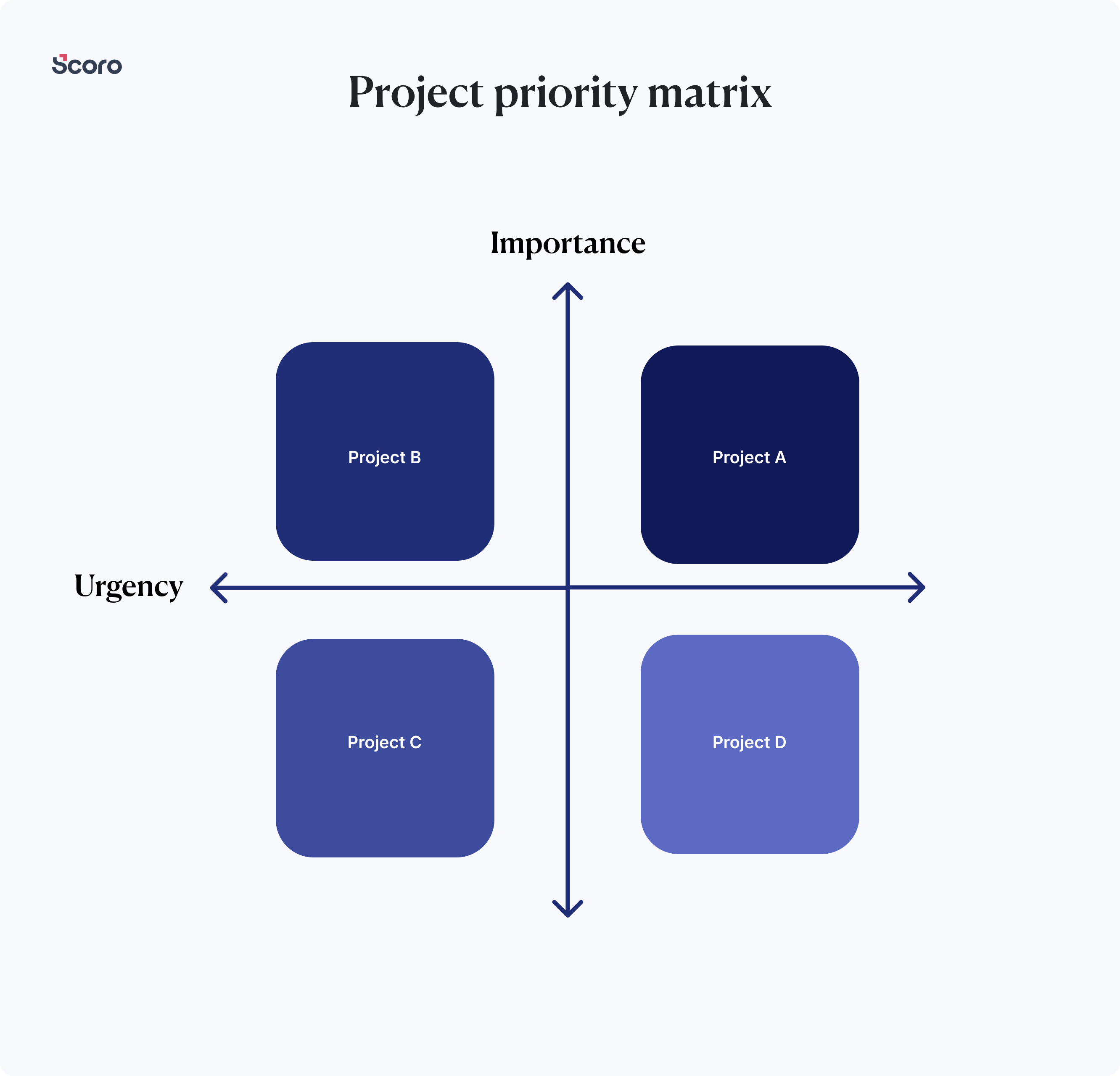
What does this look like in practice?
Imagine your agency has received inquiries for four potential projects. You need to evaluate which ones to take on and how to prioritize them.
| Client | Project | Value | Margin | Deadline | Labor |
|---|---|---|---|---|---|
| Client A | Website redesign with SEO | $75,000 | 50% | 3 weeks | Senior designer, developer, SEO specialist |
| Client B | Comprehensive brand strategy | $120,000 | 40% | 10 weeks | Brand strategist, designer, project manager |
| Client C | Social media ad campaign | $15,000 | 30% | 2 weeks | Social media manager, junior designer |
| Client D | Logo refresh | $3,000 | 60% | Flexible | Graphic designer for a few hours |
Using the project priority matrix, you decide:
High urgency & high importance: Client A: Website redesign
- High-value ($75,000) retainer client with a 50% margin and a 3-week deadline. You could assign senior staff immediately to deliver on time and maintain the relationship.
High importance & low urgency: Client B: Brand strategy
- Largest project value ($120,000) and a 40% margin with a 10-week deadline. Plan now but schedule execution after urgent projects are completed.
High urgency & low Importance: Client C: Social media campaign
- Low value ($15,000), a smaller 30% margin, and a 2-week deadline. Accept only if junior staff are available after higher-priority work.
Low urgency & low importance: Client D: Logo refresh
- Low value ($3,000) despite a high 60% margin and flexible timing.Decline or defer to a slower period.
To make informed decisions on which projects to prioritize, use Scoro’s “Profitability by projects” report to identify high-performing and low-performing projects based on profitability.
You can find it in the report library. Click “Profitbailty” > “Profitabilty by projects.”
You will then see a report that looks similar to this:
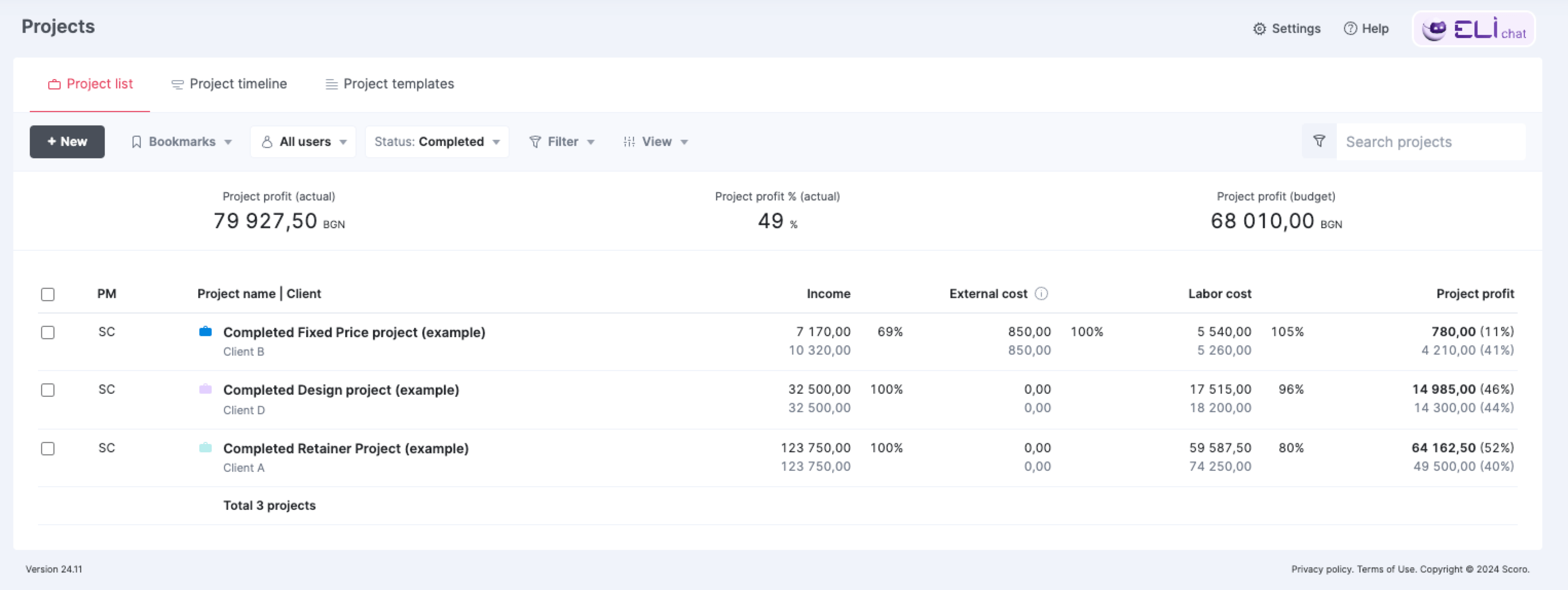
Key metrics in the report include:
- Income: Total revenue generated by each project based on issued invoices
- External cost: Expenses incurred during project delivery, including supplier bills
- Labor cost: Internal cost of delivering the project
- Project profit: Revenue after deducting delivery costs
What to look for:
- High-margin projects: Identify project types that regularly produce strong project profit and prioritize them in your pipeline
- Low-margin projects: Spot projects that consume significant resources but yield low profitability. Consider whether these can be streamlined, repriced, or avoided in the future.
Step 2: Forecast resource demand for every incoming project
After using the project priority matrix to decide which projects to accept, the next step is to forecast resource demand.
Forecasting resource demand helps you:
- Plan ahead and allocate resources effectively
- Avoid overbooking or underutilizing team members
- Ensure high-priority projects are delivered on time and within scope
Start by listing all confirmed and potential projects in the pipeline. Include their start and end dates, as well as the estimate of the total number of hours needed to complete the project.
This gives you a timeline of when you’ll need people. And helps you identify potential bottlenecks.
Next, break down each project into the specific roles and skills needed.
For example, a website redesign project might need a UX designer with wireframing skills, a full-stack developer proficient in JavaScript, and a project manager.
Let’s say you’ve decided to take on the following projects:
| Client | Project | Hours needed | Roles required | Timeline |
|---|---|---|---|---|
| Client A | Website redesign with SEO | 200 | Senior designer, developer, SEO specialist | 3 weeks |
| Client B | Comprehensive brand strategy | 300 | Brand strategist, designer, project manager | 10 weeks |
With this information, you can now forecast team capacity:
- Assign specific team members to each role
- Ensure workloads are evenly distributed to avoid bottlenecks
A resource management tool like Scoro can help you forecast resource demand by turning project quotes into tentative bookings. Giving you a visual overview of resource availability.
Here’s how:
Start building your quote and add the required roles or specific team members and the estimated hours of service.
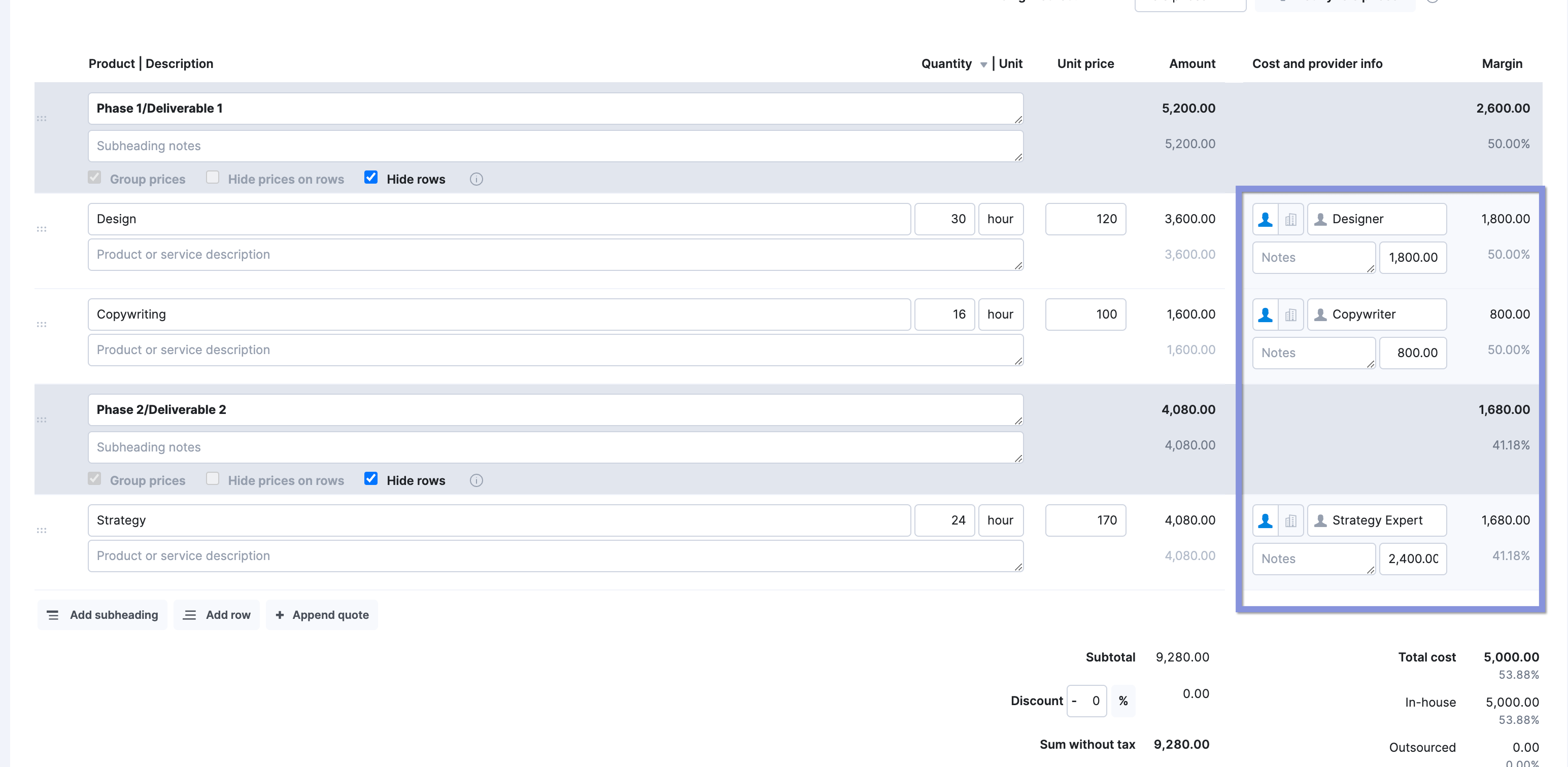
After you save the quote, click “Create project” in the project details view. Scoro automatically creates a project team based on the roles or team members listed in the quote.
The quoted hours are automatically converted into tentative bookings in the “Bookings” tab:
- Green bars represent the overall utilization percentage for each team member or role across all projects.
- Purple bars represent specific bookings for this project. They either show a percentage of time per day or hours per day.
- Solid-colored bars indicate fixed bookings, while striped bars represent tentative bookings
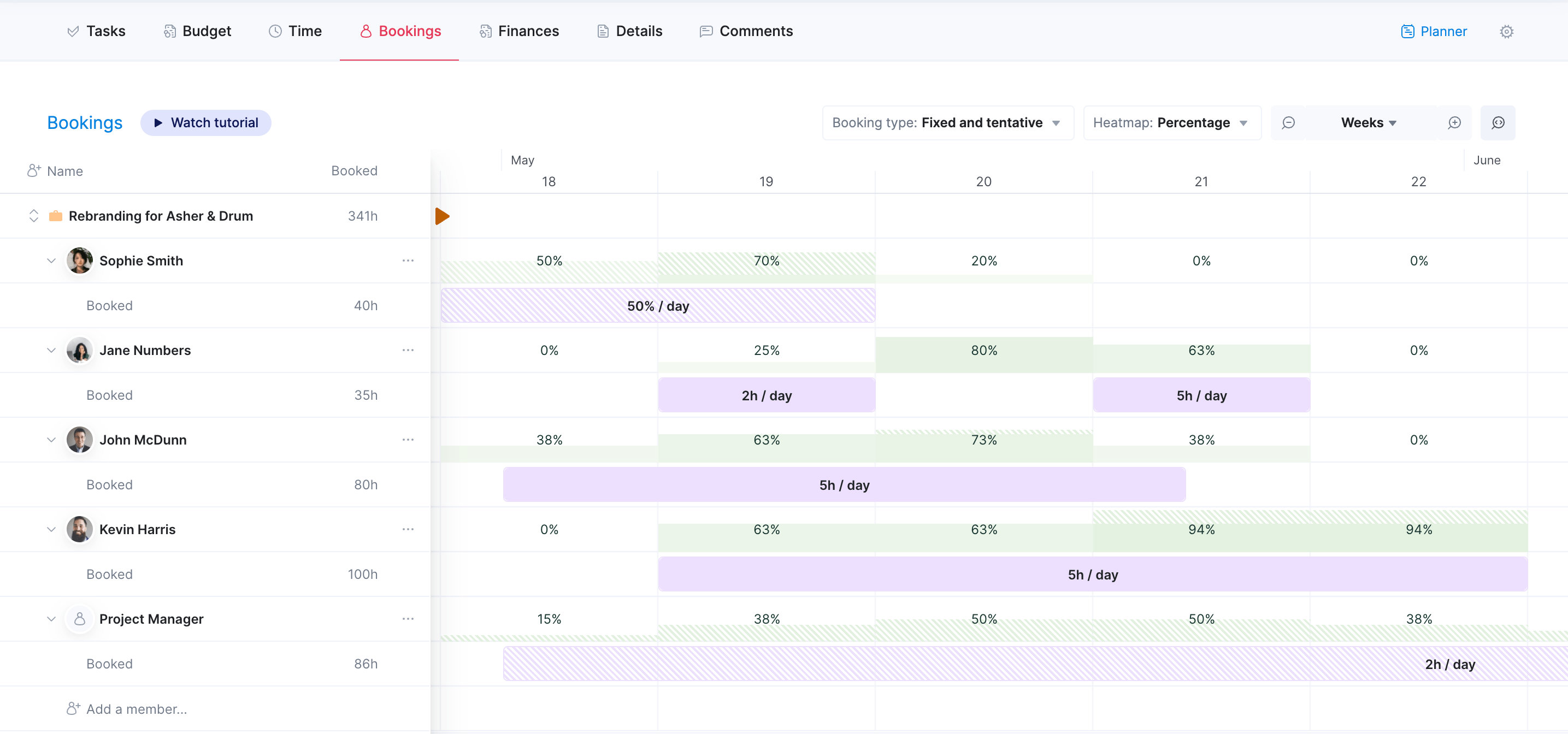
Step 3: Assess the team’s current resource capacity
Once you’ve forecasted resource demand for high-priority projects, the next step is to assess your team’s current capacity.
This helps you determine:
- What projects you can realistically take on
- When you might need to bring in additional support or adjust timelines
Create a roster of your team members and their roles (e.g., Senior Designer, Junior Developer). Include their contracted hours and note any part-time arrangements.
Then, determine their available hours on a monthly basis by:
- Calculating their contracted hours per month
- Subtracting estimated non-billable time (meetings, admin tasks) based on past data or company averages
- Accounting for planned absences (vacation, sick leave) from your HR system or team calendar
Suppose a developer has a 40-hour workweek. They spend five hours in meetings and have a week of vacation planned for a month.
- Total hours: 40 hours/week * 4 weeks = 160 hours
- Subtract non-billable time: 5 hours/week * 4 weeks = 20 hours
- Subtract vacation: 1 week = 40 hours
Or, if you’ve created tentative bookings in Scoro, you can look at the utilization heatmap to get an initial overview of the potential demand on your team’s time.
The heatmap compares the resource’s total availability in the given period with their bookings across all projects to calculate their utilization.
For example:
Jane and Dave are Copywriters. Their total daily availability is 8 hours, which means the maximum total availability for the Copywriter role is 2 x 8 = 16 hours per day.
If Jane already has 6 hours booked and Dave has 4 hours booked, it instantly means the availability of the Copywriter role is now 16 – (6 + 4) = 6 hours.
Now, let’s suppose we also book the Copywriter as a placeholder for 3 hours on Monday. This means the utilization of the Copywriter placeholder on Monday is instantly 50% because the total availability was 6 hours to start with.
The calculation: bookings for the placeholder (3 h) / availability of the role (6 h) = 50%.
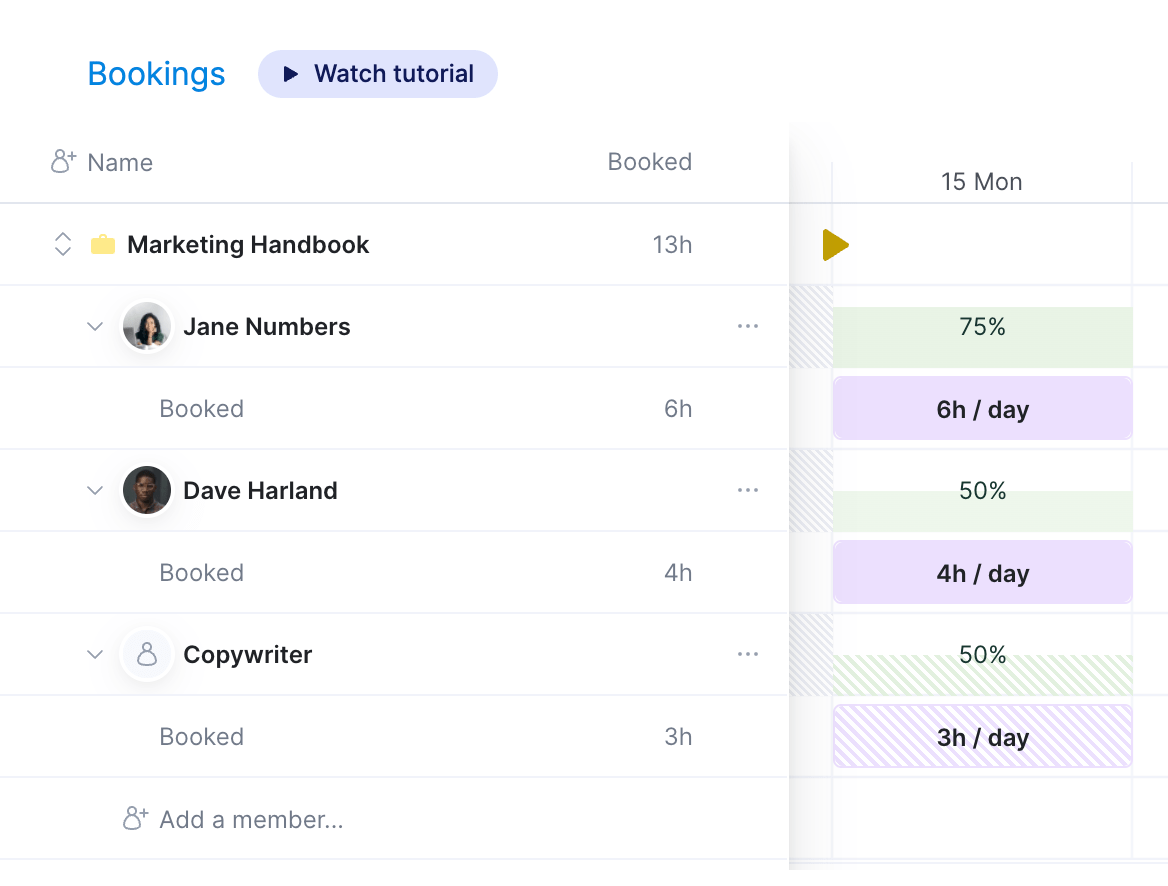
You can also check the current availability of the placeholder by clicking on the heatmap.
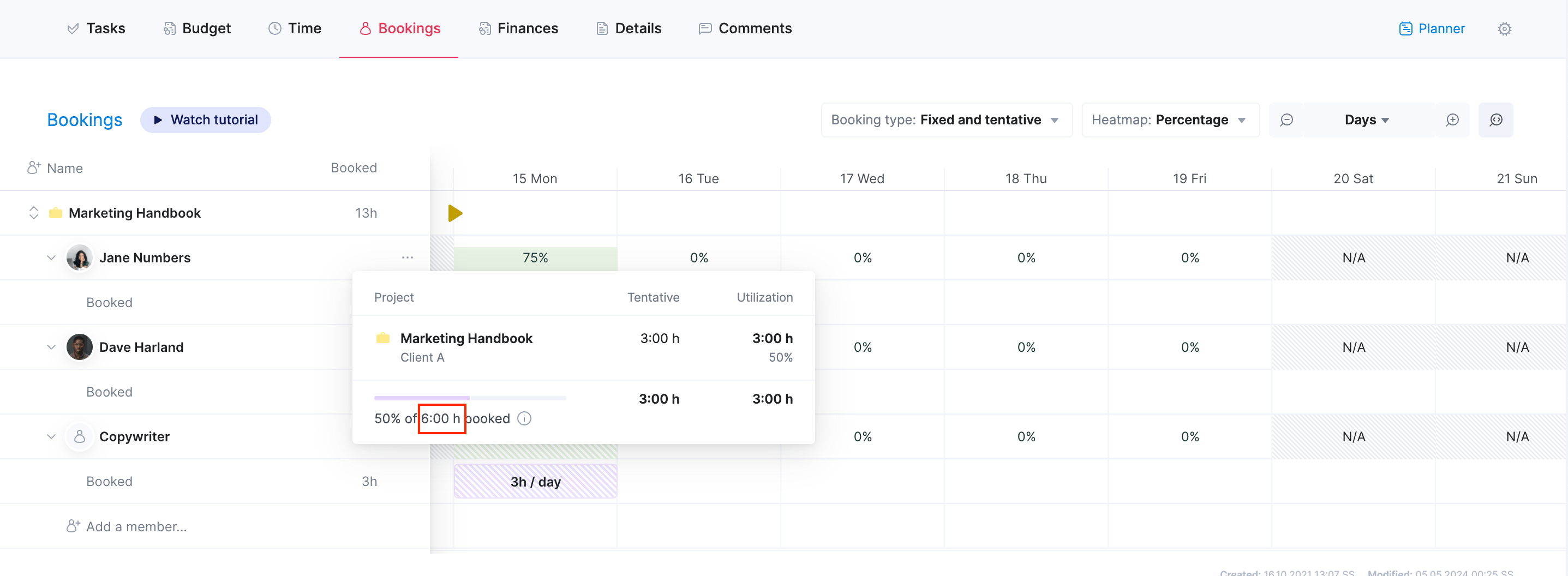
By visualizing resource availability and tentative bookings, you can get an initial overview of your team’s potential workload. At this stage, review the tentative bookings and identify any obvious imbalances or potential issues.
Step 4: Evaluate the overall impact on capacity
Once you understand your team’s available hours and the estimated effort required for each project, it’s time to find the sweet spot between these two.
Say your team consists of four members: Sophie, Kevin, John, and Jane. Sophie and Kevin are full-time, while John and Jane are part-time.
After accounting for meetings and vacations, they collectively have 480 available hours next month.
Your project pipeline includes three website development projects:
- Project A: Estimated 200 hours
- Project B: Estimated 150 hours
- Project C: Estimated 250 hours
The total estimated time needed for those projects is 600 hours, which exceeds your team’s capacity by 120 hours. This indicates potential overbooking and the need to adjust.
Consider the following strategies:
- Re-evaluate estimates: Double-check the estimated hours for each project. Are they realistic based on past experience? Could any tasks be streamlined or automated to reduce the required time?
- Manage client expectations: Communicate proactively with clients about potential delays or resource constraints and explore options for adjusting deadlines or project scope.
- Defer non-essential tasks: Identify any non-essential tasks within the projects that can be postponed to a later date without significantly impacting the overall goals.
- Reallocate: Explore the possibility of outsourcing certain tasks or partnering with other teams/departments to share the workload.
Let’s say kevin is already heavily booked on other projects. But Jane and Sophie have some availability.
You decide to:
- Reassign tasks: You identify tasks in Project C that can be delegated to Jane and Sophie, reducing Kevin’s workload.
- Shift deadlines: You discuss the possibility of extending Project C’s deadline by a week with the client, freeing up time to concentrate on other high-priority tasks
For example, in Scoro’s bookings heatmap, you can adjust the daily workload, or change the booking type, by clicking on the booked slot.
This opens up the booking modal, where you can change the details.
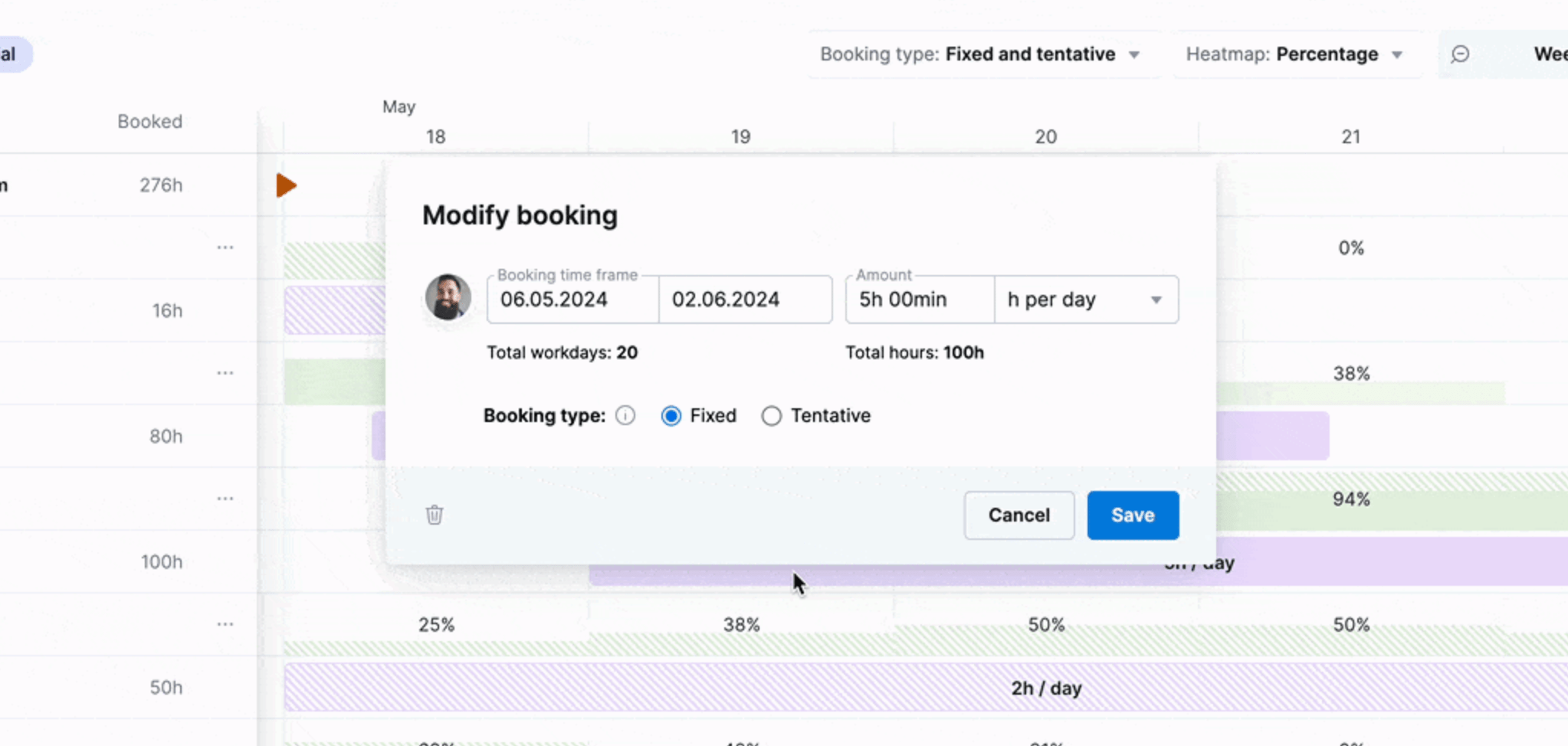
Alternatively, you can adjust the time frame of the booking by simply dragging it.
Step 5: Identify capacity gaps for the following quarters
Once your immediate capacity plan seems set, it’s crucial to assess its long-term viability.
Look ahead at your team’s workload for the coming months to proactively identify and address potential issues before they derail your projects.
You can do this by using the “Utilization report” in Scoro. Go to the “Reports” module and click on “Utilization report.”
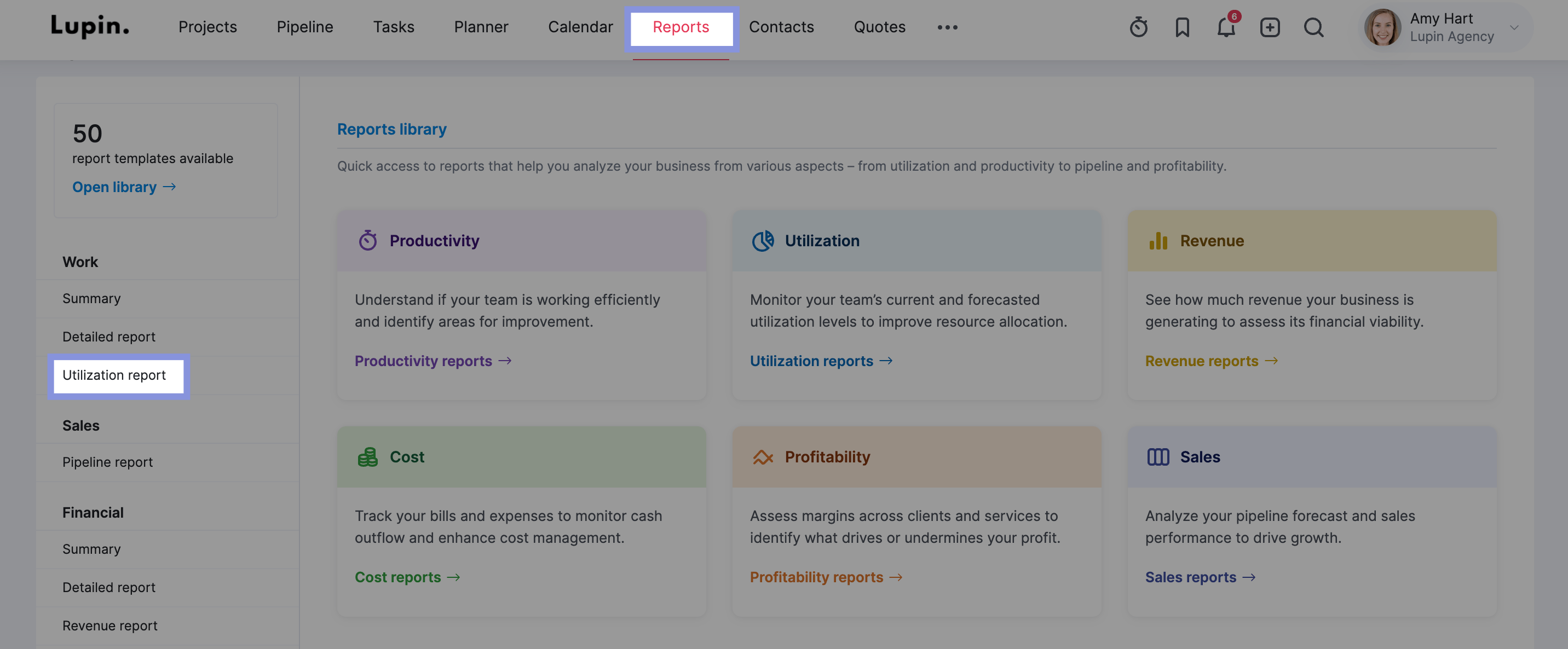
Then, adjust the the report to cover the next quarter or a custom period you want to analyze. This gives you a broader perspective on your team’s workload over time.
Timeframes include the next 7, 14, 30, 90 or 365 days.
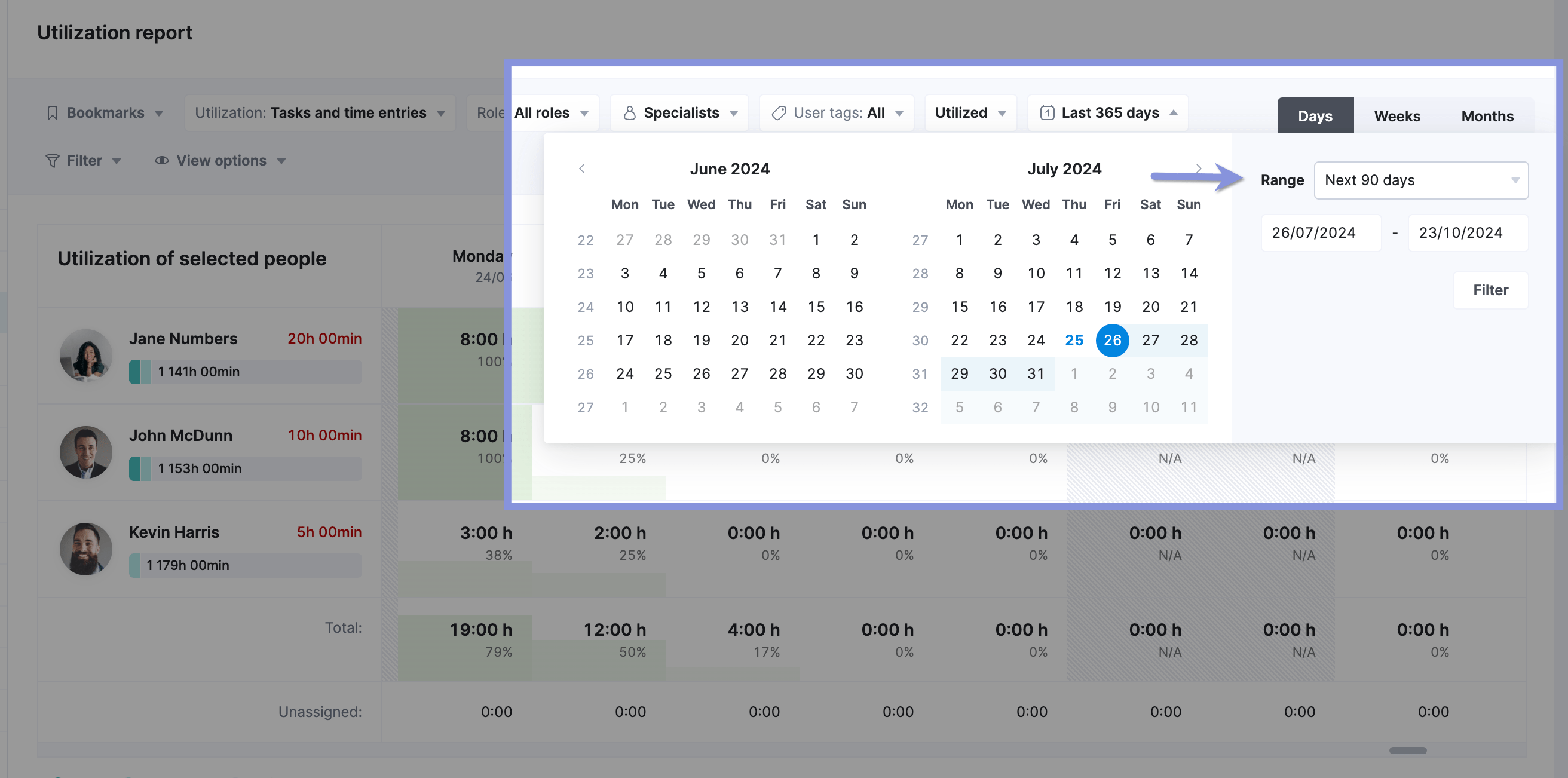
You can then get a good sense of your team’s capacity for the upcoming months.
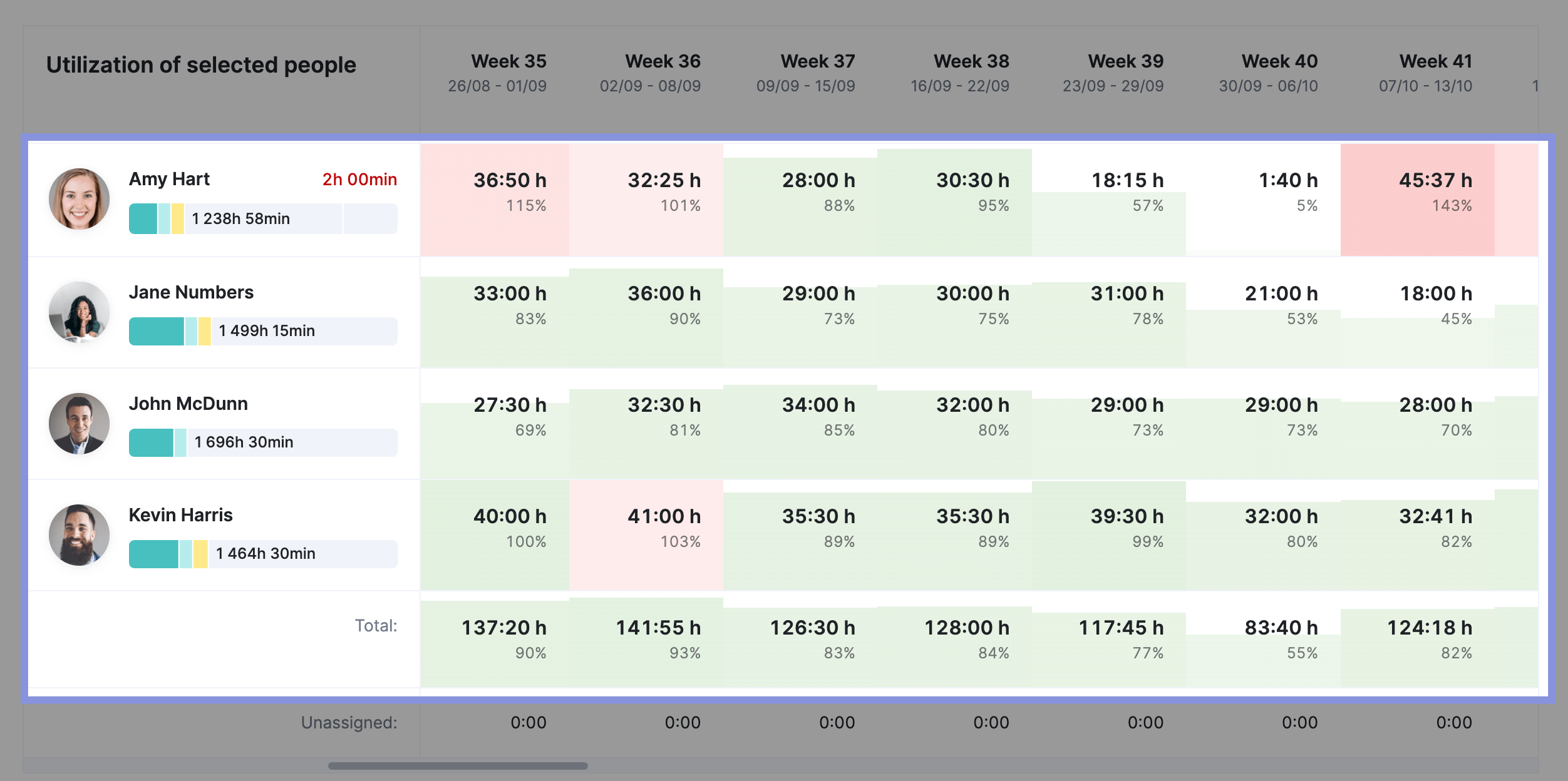
You can also filter the report by role by clicking the “All roles” tab and then a specific role to pinpoint specific areas where you might face resource constraints or skill gaps.
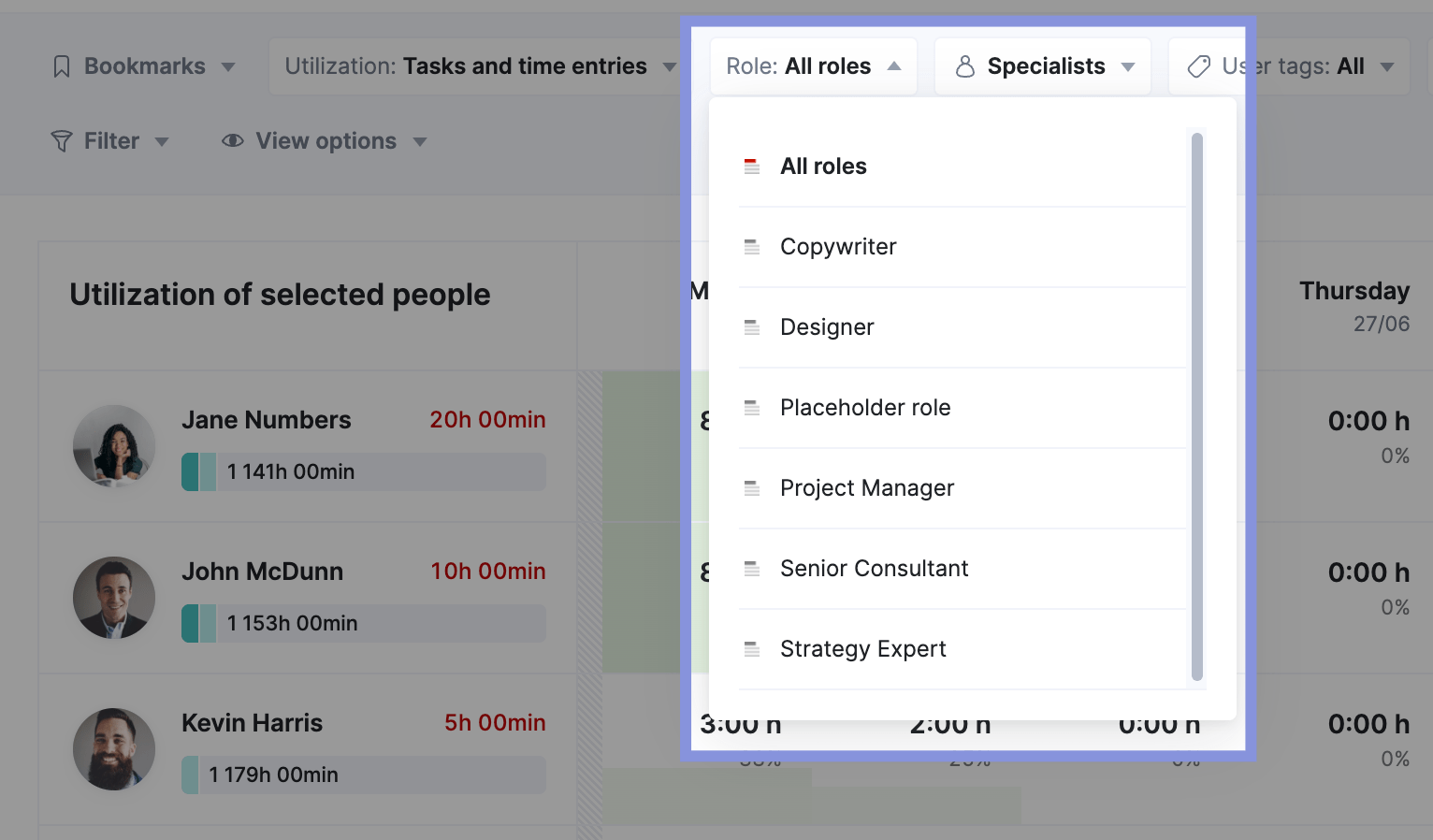
Furthering Reading: Employee Utilization Reports 101: Your Ultimate Guide
Scoro’s “Project timeline” view gives you another clear way to visualize your project timelines and avoid potential resource conflicts:
- Yellow bars represent future work that hasn’t started yet, allowing you to see upcoming project demands
- Gray bars indicate work currently in progress
- Blue bars show completed phases, giving you a sense of project history and progress
- Red bars highlight where multiple projects overlap in time—warning signs of potential bottlenecks
Aava & Bang, a marketing agency with over 50 employees, faced significant challenges in managing team workloads and project timelines. By implementing Scoro, they transformed their approach to capacity planning:
- Challenges: Lack of insight into team workload and difficulty in forecasting capacity led to inefficiencies and overwork.
- Solution: Using Scoro’s centralized project management and resource allocation tools, Aava & Bang streamlined time management and enhanced team collaboration.
- Results: The agency reported improved workload balance, better prioritization, and an increased ability to make data-driven decisions. According to their Art Director, “Creative work requires careful time planning. With Scoro, we’ve been able to strike that balance.”

Build a strong foundation with capacity planning
Capacity planning is key to delivering projects on time and within budget, preventing burnout, and keeping your team engaged.
However, capacity planning is only the first step in the project resource management puzzle. Next, you need to master resource planning.
Check out our resource planning guide to learn how to improve your staffing choices and balance required expertise with labor costs to keep clients and your company happy.
Ready to try Scoro?
Get a 14-day free trial today.





